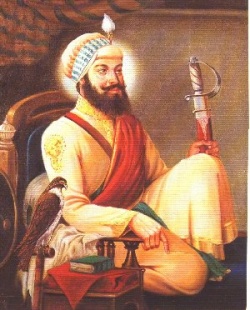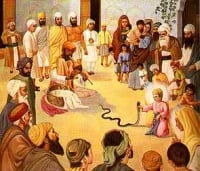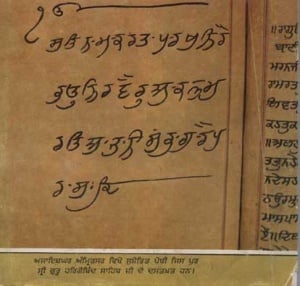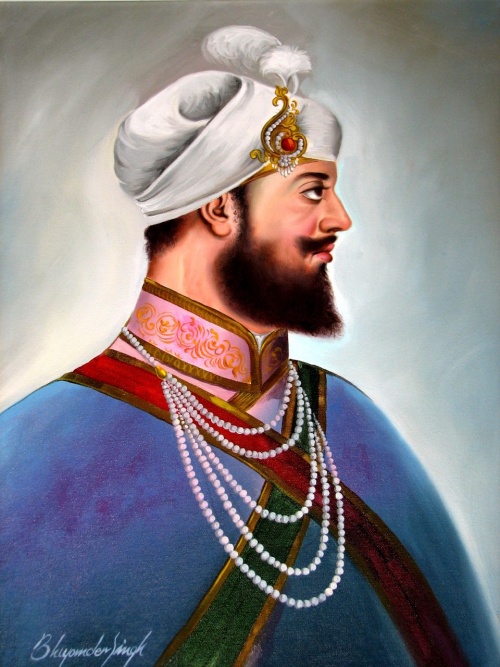Guru Har Gobind
| Guru Har Gobind (1595 to 1644) | |
| Full Name : | Har Gobind |
| Personal Details | |
| Birth : | 19 June 1595, Guru ki Vadali in Dist. Amritsar |
| Guruship : | 11 June 1606 |
| Joti Jot : | 03 March 1644 |
| Family | |
| Parents : | Guru Arjan Dev & Mata Ganga |
| Brother/Sisters : | -N.A- |
| Spouse : | Mata Nanaki, Mata Mahadevi,Mata Damodari |
| Children : | Sons - Baba Gurditta, Baba Suraj Mal, Baba Ani Rai, Baba Atal Rai & Guru Tegh Bahadur Daughter - Bibi Biro |
| Other Details | |
| Bani in GGS: | {{{Bani in GGS}}} |
| Other Info: | Built the Akal Takhat, First Guru to engage in warfare, Main battles fought: Amritsar, Sri Hargobindpur, Guru Sar Marajh and Kartarpur |
Guru Arjan in captivity and under severest torture, concentrated and sought on God for guidance to save the nascent Sikhism from annihilation. The only solution revealed to him was to guard it with the use of arms. He pondered over it again and again to conclude that militarisation of Sikhism was the only remedy. Hence he sent to his young son and successor, eleven year old Har Gobind, and nominating him as the Guru of Sikhs gave his last injuction through a Sikh disciple; "Let him sit fully armed on his throne and maintain an army to the best of his capacity".
Guru Har Gobind Ji (Gurmukhi: ਗਰੂ ਹਰਿ ਗੋਬਿੰਦ) (19 June 1595 - 03 March 1644) was the sixth of the Ten Gurus of Sikhism and became Guru on 11 June 1606 following in the footsteps of his father Guru Arjan Dev Ji. While the ceremonial rites were being performed by Baba Buddha ji, Guru Har Gobind ji asked Baba Buddha to adore him with a sword. Guru Har Gobind put on two swords simultanously, one on his left side and another on his right. He declared that the two swords signified "Miri" and "Piri", "Temporal Power" and "Spiritul Power", one would smite the oppressor and the other would protect the innocent. He told his followers: "In the guru's house spiritual and mundane powers shall be combined". "My rosary shall be the sword-belt and on my turban i shall wear the embelm of royalty". Guru Har Gobind carried the torch lit by Guru Nanak; but he added to it the lustre of the sword.
Recruiting troops
Guru Har Gobind ji excelled in state and splendour; arming and drilling some of his devoted followers, he came to possess seven hundered horses, three hundered horsemen and sixty gunners in due course of time. Five hundered men from 'majha area of Punjab' were recruited as infantry. He built a fortess at Amritsar and called it 'Lohgarh' or fortess of steel. He had his own flag and war-drum which was beaten twice a day. The Mughals believed that all this had a political complexion.
Akal Takht
Guru Har Gobind constructed Akal Takht or God's throne in front of Harmandir in 1606. There he sat on a raised platform of twelve feet, attired in princely clothes. Harmandir Sahib was the seat of his spiritual authority and Akal Takht the seat of his temporal authority. This marked the transformation of Sikhism and begginning of the Sikh militarisation. To the symbols of sainthood were added marks of sovereignty, including the umbrella and the crest. Guru Har Gobind administered justice like a King and awarded honours and punishment. Akal Takht was the first Takht in history of the Sikhs. According to Cunningham : "The genial disposition of the martial apostle led him to rejoice in the companionship of a camp, in the dangers of war, and in the excitements of the chase".
State within a state
The Sikhs had formed a seperate and independant identity, and had nothing to do with the goverenment agencies of the day. Thus the Sikh entity came to occupy a kind of seperate state within the Mughal Empire.
Congregational prayers
Guru Har Gobind ji established congregational prayers adding to religious fervour among his sikhs, but also strenghtened their unity and brotherhood. Mohsin Fani, author of 'Dabistan', states that when a Sikh wished for a favour or gift from God, he would come to assembly of Sikhs and request them to pray for him; even the Guru asked the Sikh congregation to pray for him.
Enemies
There were many enemies of Guru Hargobind. His uncle, Priti Mal, who was brother of Guru Arjan continued his intrigues against Guru Har Gobind. Prithi Mal had un-successfuly tried to kill Guru Har gobind, when the guru was a child, by unleasing a deadly snake upon him. Prithi Mal continued to complain against him to Emperor Jehangir.
Chandu Shah had been foremost in complaining to Jehangir against Guru Arjan Dev ji. He continued his hostilities against Guru Har Gobind.
Shaikh Ahmad Sirhandi too was a foe of Sikh Gurus and would have incited the Emperor.
Jehangir himself was the enemy of Guru Har Gobind. He had issued orders for torturing Guru arjan and was hostile to his successor.
Religious activities
Guru Har Gobind did not neglect the work of preaching and spreading the Sikh religion. He sent his Sikhs to far of places such as Bengal and Bihar to preach Sikhism. Guru Har Gobind allowed Udasis to preach Sikhism but did not admit them to Sikhism. Bhai Gurdas mentions in his var 2 the names of Nawal and Nihala, two sabharwal khatris, who established their bussiness in Bihar. A lot of local people adopted Sikhism under their influence. In his private life Guru Har Gobind never abandoned the true character of Guru Nanak, whose successor he was and whose light he had to spread in this world.
The following is a summary of the main highlights of Guru Ji's life:
- Transformed the Sikh fraternity by introducing martial arts and weapons for the defence of the masses following his father's martyrdom
- Militarised the Sikh movement. Carried 2 swords of Miri and Piri
- Built the Akal Takhat in 1608 - which is now one of five Takhats (Seat of Power) of the Sikhs
- Founded the city of Kiratpur in District Rupnagar (old name Ropar), Punjab
- Guruji was imprisoned in the fort of Gwalior for one year and on release insisted that the other 52 fellow prisoners be freed as well.
- To mark this occasion the Sikhs celebrate Diwali
- First Guru to engage in warfare
- Fought 4 battles with the Mughal rulers
Born: 19 June 1595
Place of birth: Guru ki Vadali, district Amritsar
Parents: Sri Guru Arjan Dev Ji and Mata Ganga Ji
Spouses: Mata Damodri Ji, Mata Nanki Ji and Mahadevi Ji
Children: Baba Gurditta Ji, Baba Ghani Rai, Surajmal Ji, Baba Attal Ji, Sri Guru Tegh Bahadur Ji and Bibi Veero
Period: During the reigns of Emperor Jehangir and later Shahjehan in Delhi
Main battles fought: Amritsar, Sri Hargobindpur, Guru Sar Marajh and Kartarpur
Died: 3 March 1644
Detailed Account
The sixth guru, Guru Hargobind Ji occupies a special place in Sikh history because, after Guru Arjan Dev Ji's martyrdom, he gave a new direction to the course of events. Along with his spiritual authority, he exercised temporal authority too by expounding the concept of Miri and Piri (the temporal and the spiritual). In Indian history the advent of Sikhism and the establishing of Mughal Empire took place at the same time. Sikhism was not against Islam at all. It was against the feudal and imperial set up that was encouraging injustice, oppression and exploitation. The scourges of caste divisions, religious discrimination and superstitions had made life hell for an ordinary person. The oppressors would shield behind Islam as well as Hinduism. Guru Hargobind Singh Ji used both the powers of worship and of the sword to fight this oppression.
Guru Ji was born on 19 June 1595 to Mata Ganga Ji and Sri Guru Arjan Dev Ji in village Wadali of district Amritsar. He was merely eleven years old when Guru Arjan Dev Ji was martyred under Jehangir's orders. At the time of his installation as the guru, Guru Ji asked Baba Budha Ji to discard the earlier tradition and arm him according to a new tradition. Baba Ji armed him with a three feet sword but it was put on the wrong side by mistake. When Baba Budha Ji tried to change the side, Guru Ji asked him to let it be and put another one on the other side instead. Baba Budha Ji acceded to his request and Guru Ji announced the purpose of two swords. One was to signify the temporal power and the other, the spiritual power. His purpose was not to mix religion with politics, but to take up the cause of the exploited and defend them against the oppression of the rulers. The Moguls had already entangled religion with politics and as a result the people were being subjected to persecution and injustice. History shows that politics always dominates religion and the ruling classes oppress the people from behind the shield of religion. That is why the politicians have always played the game of entangling religion with politics.
According to the chronicles, Guru Arjan Dev Ji did not beget a child for a long time and Mata Ganga Ji sought Baba Budha Ji's blessings for an offspring. Budha Ji had told her that she would give birth to an extraordinarily chivalrous son. Guru Hargobind Ji was born after that. Guru Hargobind Ji issued many edicts after he was installed as the sixth guru. He set up an army, acquired arms and horses, hoisted the Sikh flag and used large drums (nagaras) to make announcements. In 1663 he had the Akal Takhat built in front of Harimandir Sahib. Seated here he would listen to the woes and complaints of people and issue edicts.
According to historians, he was married thrice but this concept is confusing and probably not accurate. It is also said that the name of bride before marriage changed after marriage in the husband's house as was the custom at the time. Historians say that Guruji's first wife was Mata Damodari daughter of Narain Das of village Talla. She gave birth to Baba Gurditta, Bibi Veero and Ani Rai Ji. The second time he was married to Bibi Nanki daughter of Hari Chand of village Bakala. She was the mother of Guru Tegh Bahadur Ji. His third marriage was to Bibi Mahadevi daughter of Daya Ram of village Jandiyali, district Shekhupura (Pakistan). She gave birth to Suraj Mall Ji and Baba Atal Ji.
In Gwalior Fort, alarmed by the spreading glory of Guru Hargobind Ji, all the ill-wishers of the community joined hand with the rulers of Lahore and went to Delhi to complain against him to the Mughal rulers. They told Jehangir that Guru Hargobind Sahib was gathering an army and amassing arms to avenge his father's death. It would be advisable to suppress his efforts at the earliest. Jehangir summoned the Guru to Delhi to assess his ideas and then had him confined in Gwalior fort where fifty-two rulers were already imprisoned. After spending some time in Guru Ji's company in the jail, these potentates came under his influence and became his followers.
Meanwhile Chandu, an ill-wisher was hatching conspiracies to have Guru Ji killed in the jail. Nevertheless Guru Ji's following amongst the people was increasing despite his incarceration. The famous muslim pir (saint) Mian Mir counselled Jehangir to release Guru Ji and he accepted his advice. But Guru Ji said that he would leave the fort only if the other fifty-two would also be released with him. Jehangir accepted this condition too and the fifty-two imprisoned rulers were released along with him. That is why Guru Ji is referred to as the Liberator (Bandi-chor) in history. When Guru Ji reached Amritsar his Sikhs lit lamps to welcome him. Since then the festival of Deep-mala (lighting of lamps) is celebrated to commemorate the occasion.
From Amritsar he went to Lahore where Kaulan, daughter of Kazi Rustam Khan and a follower of Saint Mian Mir came into contact with the Guru due to her dire plight. Guruji's asked her to move to Amritsar, where she led a pious life. On Guruji's command, Baba Budha Ji had Gurdwara Kaulsar built in Kaulan's memory in 1681 of Bikrami calendar. On the invitation of Sikhs of central India he also travelled there and had Gurdwara Nanak Matta completed there. Later he visited Kashmir and secured many followers there. He returned to Punjab via Gujrat. In reply to the four questions of Jehangir, disciple of Shah Tola, Guru Ji had said:
1.The woman is the honour of a man
2. A son is the mark of a man
3. Money is transient
4. A sage is neither a Hindu nor a Muslim
| Battles By Guru Har Gobind |
|
Battle of Amritsar || Battle Of Hargobindpur || Battle Of Gurusar || Battle Of Kartarpur || Battle Of Kiratpur |
Guru Hargobind Sahib fought four battles in his lifetime. Emperor Jehangir died in 1684 Bikrami and his son Shah jahan ascended the throne. The ill-wishers renewed their conspiracies and incited him too against Guru Ji. Otherwise also Shahjehan was insecure about the increasing influence and power of Sikhs. Sikhs trapped a falcon belonging to Shahjehan and a conflict with imperial bandits ensued. On the 22 day of Jeth month in Bikrami 1685, Sikhs won this battle. After winning it, Guru Ji married off Bibi Veero. In 1687 a battle was fought near village Ruhela where Moslem army and Turk chieftains were defeated. Guru Ji renamed this village as Hargobindpur. The third battle started when Bidhi Chand stole Guru Ji's horses from Lahore fort; this battle too was won. The fourth battle took place near Kartarpur with Said Khan in Bikrami 1691. Lahore province was on Said Khan's side. Said Khan and his fellow chieftains were killed and the Guru's army won the battle. In 1701 Bikrami Guru Ji called his followers and passed on the mantle to his grandson Sri Har Rai Ji in their presence. The very same evening he passed away .It was the third day of March in year 1644.
| Preceded by: Guru Arjan Dev (15 April 1563 - 30 May 1606) |
Guru Hargobind | Followed by: Guru Har Rai (26 February 1630 - 30 May 1661) |
| These are the Ten Gurus of Sikhism |
|
Guru Nanak | Guru Angad Dev | Guru Amar Das | Guru Ram Das | Guru Arjan | Guru Hargobind | Guru Har Rai | Guru Har Krishan | Guru Teg Bahadur | Guru Gobind Singh |
External Links
Audio: Sukhmani Sahib Mp3,Real Audio, Real Audio download




